US President Joe Biden’s administration on Tuesday finalised a rule mandating the removal of the nation’s remaining lead pipes within a decade, a move aimed at preventing millions of people from being exposed to the toxic metal linked with childhood developmental delays.
The policy is a cornerstone of the White House’s environmental justice agenda, since legacy water pipes are mainly located in lower income and racial minority communities.
Since Biden took office, over 367,000 pipes have been replaced, benefiting nearly a million people, the White House said in a statement. There are around nine million more homes still served by lead lines.
“The only way forward is replacing every lead pipeline and connect the American people to clean water, no alternative,” Biden said in Milwaukee, Wisconsin, where he announced the move.
Industry groups reacted with caution, welcoming the goal of complete removal nationwide but warning of challenges ahead.
“For example, in many communities, lead service lines are partly on private property and owned by the property owner rather than the utility,” said the American Water Works Association.
“The new rule requires water utilities to replace service lines under their ‘control,’” said the AWWA, adding the rule would require more clarification to assure utilities they are acting within their legal bounds.
There is no safe level of lead exposure. It evades a key defense of the body known as the blood-brain-barrier, and even trace amounts cause irreversible cognitive damage to children.
In adults lead can cause miscarriage, stillbirth, high blood pressure, decreased kidney function and cancer.
Biden’s administration announced its intention in 2021 to remove remaining lead lines over the coming years. But the plan was initially criticized for actually slowing down the rate of replacement and even allowing small public water systems to avoid replacing them altogether.
The government was subsequently sued by nine states and the District of Columbia, as well as the environmental justice groups Earthjustice and the Natural Resources Defense Council, before strengthening its rule.
Mona Hanna, a pediatrician in Flint, Michigan, which experienced a public health crisis stemming from its lead-contaminated water supply a decade ago, said in a statement the finalized rule was “a game changer for kids and communities.”
“EPA’s finalized lead and copper rule improvements will ensure that we will never again see the preventable tragedy of a city, or a child, poisoned by their lead pipes,” she added.
Erik Olson of nonprofit National Resources Defense Council added the action “is a leap forward in protecting the health of tens of millions of Americans from this scourge.”
Funding for the initiative comes from the Bipartisan Infrastructure Law, passed in 2021, which provides $50 billion to support upgrades to the nation’s drinking water and wastewater infrastructure — $15 billion of which was dedicated to lead service line replacement.
On Tuesday, the administration announced an additional $2.6 billion in new funding to support the initiative, which will also be paid for by utilities, who will likely pass the costs on to customers.


